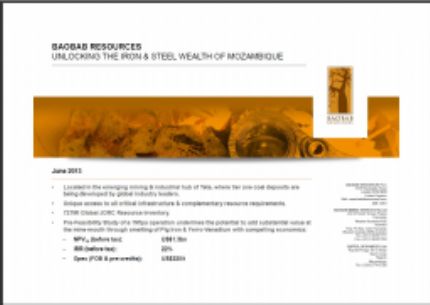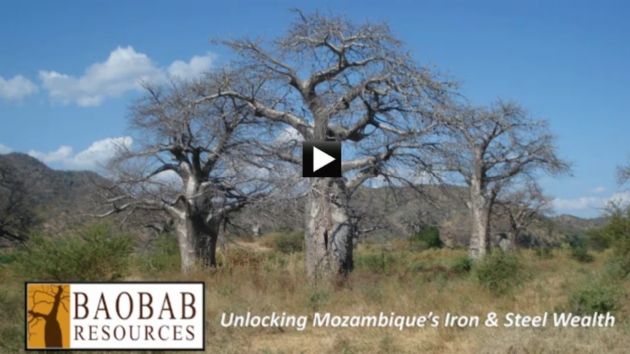 Discovery of Flux Source Within 5km of Tenge/Ruoni Deposit
Discovery of Flux Source Within 5km of Tenge/Ruoni Deposit
London, Nov 7, 2013 AEST (ABN Newswire) - Baobab Resources Plc ( LON:BAO) ('Baobab' or the 'Company') is pleased to provide further information regarding the recently discovered sequence of carbonate rocks located within 5km of the Company's Tenge/Ruoni resource block and proposed pig iron and ferro-vanadium operation.
LON:BAO) ('Baobab' or the 'Company') is pleased to provide further information regarding the recently discovered sequence of carbonate rocks located within 5km of the Company's Tenge/Ruoni resource block and proposed pig iron and ferro-vanadium operation.
HIGHLIGHTS
- A significant carbonate (limestone/dolomite) deposit has been discovered c.5km to the northwest of the 550Mt Tenge/Ruoni iron ore resource block and planned pig iron making facility. Carbonate is required as a flux in the iron making process to purge the metal of impurities and manage slag viscosity.
- In-house carbonate Exploration Target of 24.5Mt to 40.8Mt sufficient to support flux requirements for a 1Mtpa pig iron operation for a minimum of 50 years.
- Anticipated operating cost saving of c.US$5/t pig iron by quarrying rather than purchasing from suppliers, with reduced reliance on external sources and transport logistics also having a meaningful impact on the smooth operation of the facility.
- Bulk sample collected and will be incorporated in pilot plant test work programme with scout drilling to commence shortly.
Commenting today, Ben James, Baobab's Managing Director, said: 'The Company's decision to add value on site through the production of pig iron is due to the Project's unique and strategic position at the confluence of core iron and steel making commodities, namely iron ore, coal, power and water. We can now add carbonate to that list. Carbonate feed is an essential part of the iron-making progress and to find such a significant deposit so close to the Tenge/Ruoni resource block ticks another box where Baobab can guarantee security of supply.
'By incorporating the Massamba carbonate material into the on-going test work programmes, the Company will be able to provide the empirical evidence at a pilot scale that the process works and that low impurity pig iron can be won by using Baobab iron ore, Baobab fluxes and locally derived, low-cost coal.'
MASSAMBA CARBONATES - CARBONATES & THEIR USES
Carbonate rocks are a class of marine sedimentary rocks characterised by their carbonate mineralogy. Carbonates generally fall into two major categories; limestone, composed largely of calcite (CaCO3), and dolomite, formed through the magnesium (Mg) replacement of limestone. Marble is the metamorphic derivative of a carbonate rock. Igneous rocks of a carbonate composition do occur rarely, typically as intrusive or extrusive carbonatite.
Carbonate rock, typically limestone, is a core component of cement production and is also used in clean coal power generation using Circulating Fluidised Bed (CFB) boiler technology. Carbonate material (either limestone or dolomite) is also required as a flux in the iron making process to purge the metal of impurities and manage slag viscosity.
MASSAMBA CARBONATE DISCOVERY
Baobab's exploration team has discovered a package of carbonate rocks (the 'Massamba carbonates') considered suitable as a source of flux material for the Company's envisaged iron making process. The package lies within the Company's 1035L licence, located approximately 5km to the northwest of the proposed Tete pig iron project operation and belongs to the Mid-Proterozoic aged Chidue Formation, comprising a metamorphosed package of terrestrial and shallow marine sediments dominated by psammitic schists and marbles.
Field work commenced in July 2013 with the opening of lines in the bush at 50 meter intervals, oriented north-south, to facilitate detailed geological mapping. A total of 105 line kilometers were cleared. Mapping was then carried out during July and August and covered an area of approximately 8 square kilometers. Concurrent outcrop sampling resulted in the collection of 149 samples of prospective carbonate bearing lithologies throughout the mapped area.
Chidue Formation rocks underlie approximately 6.75 square kilometers within the Company's license area of which some 70% is comprised of prospective carbonate- bearing lithologies. A stratigraphically lower sequence of meta-arenites in the north of the area hosts a laterally continuous marble unit, termed MLS-N, which strikes WNW-ESE, dips between 40-50 degrees to the SSW and varies in width from 110 meters in the west to 500 meters in the east where a series of three marble units coalesce. This unit typically forms a low ridge rising to 15 meters and can be traced along 2.5 kilometers of strike within the license area.
A sheared porphyry separates the lower sequence from a broad, carbonate dominated sequence to the south. This sequence varies in width from west to east between 250-700 meters along a 4 kilometer strike length within the license area and comprises impure limestones, termed SLS, which host a number of robust lenses of marble up to 700m long by 300m wide. The marbles are termed MLS-S to distinguish them from the northern unit although both lithologies appear similar.
The southern limit of the Chidue Formation rocks is marked by a wide mylonite zone striking at 290 degrees and dipping 45 degrees to the southwest. To the south of this tectonic contact the geology is dominated by anorthosite with subordinate gabbro belonging to the Tete Suite.
The Chidue Formation rocks have been metamorphosed with strong planar fabric developed in the meta-arenites and porphyry. The carbonates rocks exhibit medium to coarse -grained recrystalization textures, weak banding and occasional quartz segregations in the form of fine, discontinuous bands and lenses.
All of the carbonate units (MLS and SLS) appear to host veins of pure calcium carbonate with or without quartz and malachite. Only one vein occurrence was identified in the field. This is exposed in a series of old workings along a 500 meter strike length and appears to have been exploited for small-scale lime production. The vein system is generally less than one meter wide and has associated quartz and minor malachite mineralization.
SAMPLING
A total of 149 rock chip samples were collected during the mapping program. Following map compilation, 40 representative samples were selected from the principal carbonate units and submitted for laboratory analysis at the SANAS accredited Inspectorate Metals and Minerals (PTY) Ltd (a Bureau Veritas group company) in Rustenburg, South Africa.
All samples were dried, weighed, crushed, split and milled prior to XRF analysis for major oxides, determination of LOI (100-1000 degrees C) and determination of CaCO3 and MgCO3 by back titration methods. The principal marble units MLS-N and MLS-S were found to be of nearly identical dolomitic composition with a combined average composition of 56.67% CaCO3 and 36.42% MgCO3. The impure limestone (SLS) reported an average of 52.96% CaCO3 and 7.9% MgCO3 with consistently elevated SiO2, Al2O3, Fe2O3 and Na2O reflecting contained alumino-silicate minerals.
A fourth population of results was identified from analytical outliers in each of the principal carbonate units. This population is characterized by extreme CaCO3 values (average 90.04%), low to moderate SiO2 (average 4.86% and low MgCO3 (average 4.9%) and is interpreted as late vein-style carbonate of likely hydrothermal origin. These samples represent 13% of the total sample population.
Ten bulk density determinations made on the MLS-N material consistently returned values close to the average of 2.72g/cc.
A bulk sample of MLS-N material has been collected and will be used in pilot plant scale comminution, beneficiation and reduction test work as well as smelting tests.
IN-HOUSE EXPLORATION TARGET ESTIMATES
The obvious initial exploration target is the robust and laterally continuous MLS-N unit. Applying a strike length of 2.5kms, an average true thickness of 120m and a BD of 2.72, Baobab's geological team have estimated an exploration target of 24.5Mt to 40.8Mt to a depth of 30m to 50m below surface. A prioritised quarrying target at the thicker eastern end of the MLS-N unit yields an exploration target of 17.1Mt to 28.6Mt over a 1km strike to a depth of 30m to 50m and a conservative true thickness of 210m. This area will be prioritized for scout diamond drilling and sampling.
Table 1MASSAMBA CARBONATESIndicative Tonnages and Grades--------------------------------------------------------------------Area Material Density Tonnes Range (Mt) Grade Ranges (%) (t/m3) Lower Upper Total Carbonate (CaCO3 + MgCO3)* (to 30m) (to 50m) Lower Upper---------------------------------------------------------------------MLS-N: Total Dolomitic Marble 2.72 24.5 40.8 87.8 99.4MLS-N: Eastern DolomiticArea Marble 2.72 17.1 28.6 87.8 98.4---------------------------------------------------------------------
* Total carbonate grade ranges represent the lower and upper limits of the analytical results of the rock chip samples collected from the target areas. The information in this report relating to exploration targets should not be misunderstood or misconstrued as an estimate of Mineral Resources or Ore Reserves. Hence the term(s), Resource(s) or Reserve(s) have not been used in this context. The potential quantity and grade is conceptual in nature, since there has been insufficient work completed to define them beyond exploration targets and that it is uncertain if further exploration will result in the determination of a Mineral Resource.BAOBAB'S IRON MAKING REQUIREMENTS & POTENTIAL COST SAVINGSBaobab's Pre-Feasibility Study ('PFS') estimated the consumption of 0.44t of dolomite per tonne of pig iron produced. The Company's exploration target estimate indicates that the Massamba carbonates are sufficient to support a 1Mtpa pig iron operation for at least 45 years. An operating cost ('opex') of US$6.60 per tonne of pig iron production was attributed to dolomite materials in the PFS (at US$15 per tonne of dolomite delivered). Preliminary investigations by the Company indicate that the cost of quarrying would be approximately US$3.30/t of carbonate, which is likely to translate into an opex saving of c.US$5 per tonne of pig iron produced. Reduced reliance on external sources and transport logistics will also have a meaningful impact on the smooth operation of the facility.The information in this release that relates to Exploration Results is based on information compiled by Managing Director Ben James (BSc). Mr James is a Member of the Australasian Institute of Mining and Metallurgy, is a Competent Person as defined in the Australasian Code for Reporting of exploration results and Mineral Resources and Ore Reserves, and consents to the inclusion in the report of the matters based on the information in the form and context in which it appears.To view the release in English, please visit:http://media.abnnewswire.net/media/en/docs/76163-LON-BAO-20131105.pdf
About Baobab Resources plc
 Baobab Resources plc (LON:BAO) is a Mozambican-focused explorer with a large landholding in the central north of the country. The company's flagship project is the Tete iron ore deposit.
Baobab Resources plc (LON:BAO) is a Mozambican-focused explorer with a large landholding in the central north of the country. The company's flagship project is the Tete iron ore deposit.
![abnnewswire.com]()
Related Companies
Social Media
Share this Article

 LON:BAO) ('Baobab' or the 'Company') is pleased to provide further information regarding the recently discovered sequence of carbonate rocks located within 5km of the Company's Tenge/Ruoni resource block and proposed pig iron and ferro-vanadium operation.
LON:BAO) ('Baobab' or the 'Company') is pleased to provide further information regarding the recently discovered sequence of carbonate rocks located within 5km of the Company's Tenge/Ruoni resource block and proposed pig iron and ferro-vanadium operation. Baobab Resources plc (LON:BAO) is a Mozambican-focused explorer with a large landholding in the central north of the country. The company's flagship project is the Tete iron ore deposit.
Baobab Resources plc (LON:BAO) is a Mozambican-focused explorer with a large landholding in the central north of the country. The company's flagship project is the Tete iron ore deposit.







